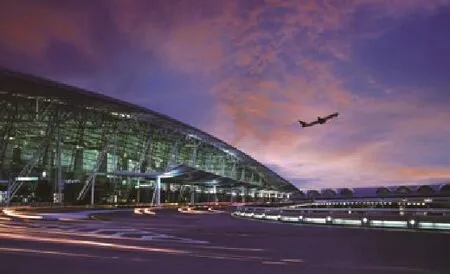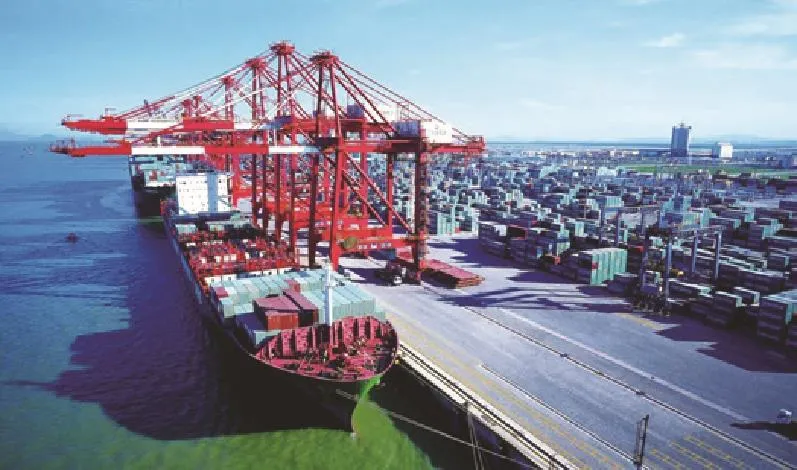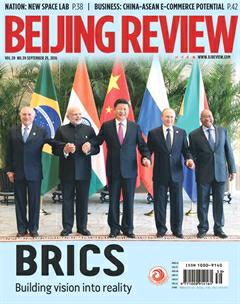Leading the Way
2016-10-22
Leading the Way
The port city of Guangzhou is poised to spearhead the Belt and Road Initiative
Alan Murray, editor of Fortune magazine,announced that the 2017 Fortune Global Forum will take place in Guangzhou, capital of south China’s Guangdong Province,at a press conference on September 13. Guangzhou was chosen as the host city for the forum not only because it is a commercial hub with over 2,000 years of history, but also because of its role as a pioneer of reform and innovation and its incentive policies for boosting trade and investment. Guangzhou has ranked first on Forbes’ List of Best Cities for Business in China five times in six years.
Guangzhou boasts a time-honored history of international exchange. The city,which has long been a foreign trade port,was a starting point of the ancient Maritime Silk Road. Guangzhou was the best-known trading port worldwide during the Qin(221-206 B.C.) and Han (206 B.C.-A.D. 220)dynasties. Its international exchanges boomed during the Qing Dynasty (1644-1911), when it was the only city open to foreign trade in China.
Guangzhou will seize the opportunity of hosting the 2017 Fortune Global Forum to have the rest of the world get a closer look at it and to attract investment from leading multinationals. It will build itself into an important center for international exchange by also seizing the opportunities presented by the Silk Road Economic Belt and 21st-Century Maritime Silk Road Initiative (Belt and Road Initiative) and taking advantage of its geographical position, markets, industries,transportation facilities and favorable cultural, ecological and commercial environment. It will also deepen economic and trade cooperation with the foreign countries involved in the Belt and Road Initiative.
Guangzhou’s trade with Belt and Road countries reached 214.27 billion yuan ($32 billion) in 2015, up 12.7 percent year on year and accounting for 25.8 percent of its total foreign trade volume that year. By the end of 2015, it had invested $1.43 billion in, and attracted $3.03 billion of investment from 21st-Century Maritime Silk Road countries. Concurrently, it had invested $420 million in, and attracted $270 million of investment from, Silk Road Economic Belt countries,which may overlap with 21st-Century Maritime Silk Road countries.
Achievements
· Building a new cooperation mechanism by adopting strategic thinking
Guangzhou is committed to building a new open economic system and promoting local development by participating in the Belt and Road Initiative. The local government has issued an action plan for pushing forward the construction of the 21st-Century Maritime Silk Road from 2015-17, setting forth its goals, tasks and plans. A working group headed by a vice mayor was formed to lead efforts in constructing the 21st-Century Maritime Silk Road, and a series of forums and conferences centering on the Belt and Road construction were held to provide intellectual support. Guangzhou has signed a 21st-Century Maritime Silk Road industrial cooperation action plan with the China-ASEAN Business Council in order to mobilize non-state sectors to contribute to the Belt andRoad Initiative.

A panoramic view of Guangzhou
· Strengthening the city’s function as a transportation hub
The Central Government positions Guangzhou as a key port city and the Guangzhou Baiyun International Airport as one of the two international aviation hubs in China in the Vision and Actions on Jointly Building the Silk Road Economic Belt and 21st-Century Maritime Silk Road issued in March 2015. Guangzhou has revved up infrastructure construction in accordance with the document, living up to its reputation as an “easy city.”
The Guangzhou Port has shipping routes to over 400 ports in more than 100 countries and regions worldwide. It operates 49 international container shipping routes and has 22 sister ports in foreign countries. In 2015, its cargo volume reached 388 million tons, up 5 percent year on year, while its container volume reached 15.038 million 20-foot equivalent units, up 7.2 percent year on year. A total of 136 international air routes link the Baiyun International Airport to 207 destinations worldwide. The airport’s passenger flow reached 55.21 million in 2015,while its cargo and mail volume amounted to 1.54 million tons, ranking third in China.
· Developing cooperation platforms through innovation
Guangzhou is stepping up economic exchanges and cooperation with Belt and Road countries using important platforms such as the Nansha area of the China (Guangdong)Pilot Free Trade Zone. Guangzhou is pushing for innovation in navigation, trade, finance and government services in the area with a number of measures. They include treating local and foreign investors equally and adopting a negative list approach for foreign investors.
Guangzhou will accelerate the development and opening up of Sino-Singaporen Guangzhou Knowledge City and build it into a premium platform to participate in the Belt and Road Initiative. More specifically,the knowledge city will formulate an action plan and come up with incentive policies for developing key industries and focus on newgeneration information technology, intelligent equipment, cultural and service industries. It will foster new energy, new materials, biotechnology, health, energy conservation and environmentally-friendly industries to form an industrial structure dominated by knowledge-intensive service industries and supported by high-valueadded advanced manufacturing industries.
· Deepening economic and trade cooperation

The Guangzhou Baiyun International Airport
Guangzhou has established close cooperation mechanisms with investment promotion agencies and business associations in countries and cities along the Belt and Road. With the help of the government, Guangzhou-based enterprises have carried out economic and trade exchanges in countries in Central Asia, the Middle East,South Asia, Southeast Asia, Europe and Africa.
Guangzhou has supported the development of overseas industrial parks and promoted the globalization of local equipment-manufacturing industries. The government has helped local enterprises such as the Guangzhou Shineng Electric Equipment Group and the Guangzhou Dongsong Energy Group set up industrial parks in Africa. It has also provided guidance to the Guangzhou Automobile Group and the Wanbao Group to establish their production bases in Russia and Italy respectively.
考核制度是实现精准化钻井的保障制度,包括对管理层(技术办公室)的考核和实施体(钻井队)的考核两个部分。
In addition to promoting two-way investment, Guangzhou has incentive policies for its enterprises to export hi-tech goods and homegrown brands’ products to emerging markets along the Belt and Road and to import energy, minerals, and agricultural products from Belt and Road countries. It has also encouraged its enterprises to develop new business models such as cross-border e-commerce in order to crack new markets and open up international sales channels.
· Enhancing the city’s role as a center for international exchange
Guangzhou’s economy has developed continuously and in a stable fashion. It has ranked third among mainland cities in GDP for 27 consecutive years. Its GDP grew 10.1 percent annually on average during the 12th Five-Year Plan period (2011-15) and 8 percent year on year during the first half of this year. Its industrial structure has been constantly optimized and approaches the level of developed countries.
Guangzhou is a gateway to the world with its world-leading seaport, airport and railway stations and information network. It is one of China’s four railway hubs, three communications centers and three Internet exchange centers. In addition, Guangzhou is a center of international commerce and investment cooperation which has trade relations with over 220 countries and regions. Of the top 500 global companies, 288 have investments in Guangzhou.

Guangzhou is announced as the 2017 Fortune Global Forum host city at a press conference on September 13
Goals
· An international shipping hub
Guangzhou is building itself into an international shipping hub by developing the Nansha area of the China (Guangdong) Pilot Free Trade Zone. It will promote the construction of the third phase of the Nansha Terminal, the fourth phase of the Nansha container project, and the Guangzhou Port deep-water shipping-lane expansion project.
Guangzhou will develop multiple modes of transport by exploring new international shipping routes and building dry ports. It will accelerate the development of a modern shipping service industry by planning and constructing shipping service zones, developing trade in major commodities and strengthening its function as an international transfer, shipping exchange and shipping financial service center. Guangzhou will support the Nansha Terminal bonded area’s development of a plastics e-commerce platform, a nonferrous metal exchange center and a logistics center for major commodities as well as cold-chain logistics. It will increase cooperation with domestic and foreign ports,promote the formation of a coalition of port cities along the Belt and Road and improve its ability to mobilize and distribute resourcesboth at home and abroad.
Guangzhou will enhance the function of the Baiyun International Airport as an aviation hub and strengthen connections between the Baiyun International Airport,the Guangzhou North Railway Station and the Datian Railway Container Transport Center. It will speed up the construction of the airport’s second terminal and fourth runway. It will focus on strengthening aircraft manufacturing and repair, aviation logistics and finance, and cross-border ecommerce industries. It will accelerate the construction of the Baiyun International Airport bonded area and promote projects such as the Asia-Pacific International Logistics Transfer Center, the Airport Bonded Logistics Center and aircraft assembly, repair and leasing.
· An international technological innovation hub
Guangzhou will construct a technological innovation corridor by focusing on state-level development areas including the Guangzhou Development District and the Nansha and Zengcheng economic and technological development zones. In 2015, the number of hi-tech companies in Guangzhou reached 1,919, and the number of business incubators amounted to 119. The city plans to increase its number of hi-tech enterprises to 6,000 and the proportion of local GDP spent on research and development to over 3 percent by 2020.
· An international trade hub
Guangzhou will encourage local enterprises to increase electromechanical, light industry, textile, pharmaceutical and health product exports to Belt and Road countries and to increase imports of oil, coal, wood,rubber and minerals from these countries. Local enterprises will be encouraged to deepen trade relations with these countries through the China Import and Export Fair,also known as the Canton Fair, and the Guangdong 21st-Century Maritime Silk Road International Expo. Guangzhou will accelerate the transformation and upgrading of local wholesale markets and integrate domestic and foreign trade in these markets in order to build itself into the most important trade hub connecting China and Belt and Road countries.
· Investment facilitation
Guangzhou will step up efforts to attract investors from Belt and Road countries,especially overseas Chinese, to invest in high-end industries in Nansha, the Sino-Singapore Guangzhou Knowledge City and the airport economic zone. It will attract enterprises from Belt and Road countries to register in the China (Guangdong) Pilot Free Trade Zone and expand their businesses in China. It will also encourage capable local enterprises to invest in economic and trade zones, contract infrastructure projects and open up new markets in ASEAN countries and Africa in keeping with national strategies such as the upgraded version of the China-ASEAN Free Trade Area and cross-border and cross-regional infrastructure construction partnerships in Africa.
The local government will provide legal and foreign exchange services as well as policy guidance for enterprises that have gone global. It will help local companies doing business in Belt and Road countries seek financial support from institutions such as the Silk Road Fund, the China-Africa Development Fund and the China-ASEAN Investment Cooperation Fund. Guangzhou will also increase cooperation with embassies, consulates and chambers of commerce of Belt and Road countries. All these measures aim to facilitate local enterprises’ efforts to set up factories, exploit resources, build marketing networks and bid for project contracts in Belt and Road countries.

The Nansha Terminal of the Guangzhou Port
